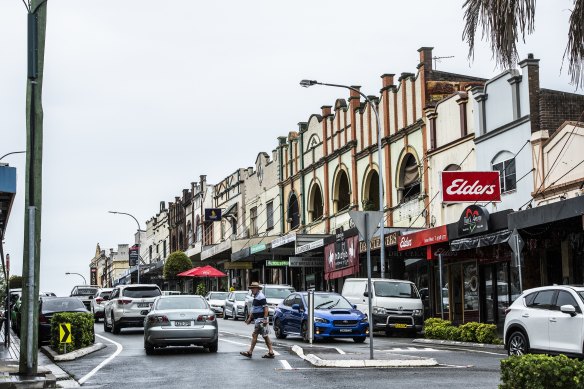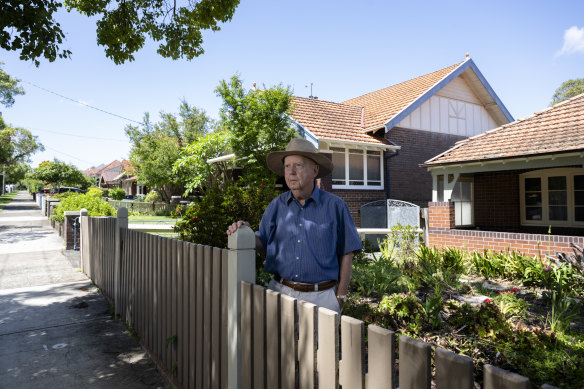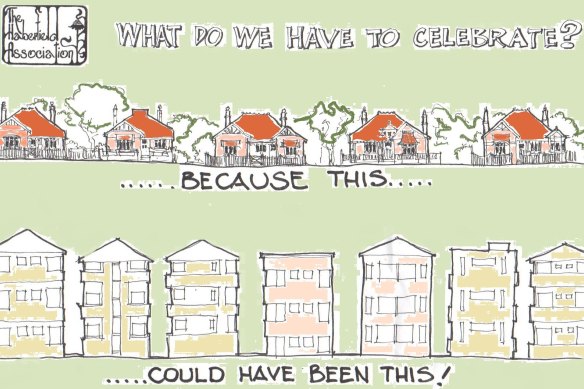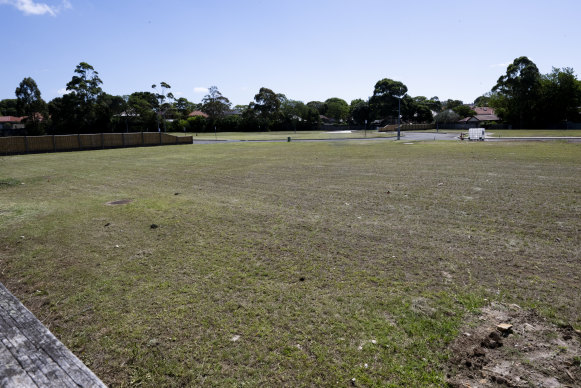This was published 10 months ago
The Sydney suburb YIMBYs love to hate, where nothing is allowed to change
Designed to be “slum-less, lane-less and pub-less”, the entire suburb of Haberfield is a heritage conservation zone – and its population is ageing alongside its houses.

Ramsay Street.Credit: Steven Siewert
Vincent Crow remembers the exact date – December 8, 1974 – he wrote to the National Trust asking it to consider heritage listings in his home suburb of Haberfield, in Sydney’s inner west.
“I said, ‘The houses here are being destroyed’. Modernised, you might say,” he recalls. A few years later, the Trust began listing parts of Haberfield, and in the mid-1980s, the Haberfield heritage conservation area was gazetted in the local environmental plan.

Vince Crow outside his Haberfield home. Like the rest of the suburb, it is within a heritage conservation zone.Credit: Janie Barrett
Today, all of Haberfield – a suburb of 6500 people about 6.5 kilometres from the CBD – remains a heritage conservation area (HCA), where development is strictly limited to preserve its form and character.
That makes it enemy number one for so-called YIMBY (yes-in-my-backyard) housing advocates, who want to see greater density around the city, especially in areas well-connected to transport.
Sydney YIMBY co-founder Justin Simon says the demographics tell the story of a suburb slowly growing older and richer alongside its houses. Census data shows Haberfield’s population barely changed between 2006 and 2021, while the number of dwellings dipped from 2505 to 2388.
In the same period, the median age jumped from 42 to 46, and median weekly household income leapt from $1291 to $2761. Half of Haberfield residents own their home outright, while just 17 per cent are renters – less than half the Greater Sydney average.
“It is a suburb that gets one or two years older in terms of median age every census,” Simon says. Then there is the median price of a three-bedroom house: “The cost of entry to Haberfield is $2.5 million.”
Haberfield is at the pointy end of a debate about whether heritage protection – especially broad heritage conservation areas that span entire streets or suburbs – is unreasonably prohibiting development, pushing up prices and making it harder for young people to buy or pay the rent.
Unlike many parts of the inner west or eastern suburbs, where HCAs contain rows and rows of Victorian terraces, Haberfield is significant as it was Australia’s first planned “garden suburb”.
Starting in 1901, real estate agent and Ashfield alderman Richard Stanton conceived it as an antidote to other parts of Sydney. Haberfield was to be “slum-less, lane-less and pub-less”.
Homes were to be single-storey, with one house per block. The standard lot size was 695 square metres, with setbacks to provide front gardens and brush box street trees out the front. No two houses were to be the same, though most were built in the Federation style.
“With Haberfield, there are hardly any houses that by themselves are outstanding architectural masterpieces,” says Crow. “It’s just the fact that it’s a single-storey garden suburb.”
Crow, 74, has lived at his three-bedroom Dudley Street property since he was eight. He also has a nearby investment property, leased to the same tenant for 15 years. The retired history teacher, who has been president of the Haberfield Association three times, says arguments to sacrifice heritage for more housing density are illogical.
“Heritage areas in the inner west are heritage because they are old. That’s what heritage is,” Crow says. “Obviously, you can’t keep everything. [But] if you are going to bulldoze it, you are going to destroy part of Australia’s heritage.”
He also argues it’s important to preserve family homes with a backyard for those who want one. “If you demolished the houses in Haberfield and built apartments, you’d only be building more of what you’ve already got elsewhere.”

Celebrating Australia’s first garden suburb: an illustration from the website of the Haberfield Association.
Crow conceded cost was an impost in Haberfield. Asked whether heritage protection had the effect of squeezing out younger people, he said: “I haven’t really given that much thought, actually.”
Crow said the answer to Sydney’s housing woes may lie in decentralisation: people could move to places such as Albury, Bathurst or Orange. “It’s up to the government to provide incentives like jobs to attract people out there,” he said.
Darcy Byrne, the Labor mayor of the inner west, says Haberfield’s heritage value is obvious and ought to be respected. But he notes the large lots and homes set it apart from the municipality’s other heritage areas. “By definition that prices a lot of people out,” he says. “There’s obviously an equity issue in maintaining houses that are that big.”
Byrne says Haberfield suffers from having such little shop-top housing, which has helped other suburbs in the inner west thrive. “It’s a downside to keeping things precisely as they are. I’m not proposing that has to change, but we should be honest about the tradeoffs,” he says.
“I personally think Haberfield could benefit from having a pub or a small bar. I don’t think you can just rip up the heritage conservation zone, but I also don’t think you can just wrap the place up in glad wrap and preserve it indefinitely as it was 100 years ago.”
Haberfield’s heritage controls have come back to the fore this year as Inner West Council grapples with a vacant, 1.9-hectare block of land – a former Army Reserve depot – on Hawthorn Parade. The block was subdivided 20 years ago for new residential development but remains vacant due to flooding concerns.

The vacant ex-army land just off Hawthorn Parade in Haberfield has been subdivided for residential development.Credit: Janie Barrett
Four of the 21 lots have been sold, and this month, the Department of Defence said it intended to put the other 17 on the market in early 2024. Due diligence on alternative uses was completed in January 2022 and came up with nothing, the department said.
Because the current rules do not contemplate the construction of new homes in Haberfield, Inner West Council is currently exhibiting site-specific development controls to ensure any new homes constructed on the site match the surrounding Queen Anne-style Federation houses, including a requirement that at least 50 per cent of each block is landscaped area.
Many controls are much more specific, such as mandating garage doors to be “simple timber or metal cladding in a recessive dark colour”.
YIMBYs, however, want those rules ripped up. Simon says the federal government, which wants the country to build 1.2 million homes in the next five years, should just gift the site to the NSW government for public housing units.
Labor councillor Philippa Scott said the council had advocated that exact position to Defence, but was rebuffed. “It’s a done deal,” she said. “We don’t live in a perfect world.”
Crow and the Haberfield Association want the block converted to a public park, not housing. A life member of the ALP, Crow is upset his federal MP – Prime Minister Anthony Albanese – has not yet met with the Haberfield Association’s army land subcommittee about the issue. “We’d only be too happy for him to come down and talk to us,” Crow said.
Start the day with a summary of the day’s most important and interesting stories, analysis and insights. Sign up for our Morning Edition newsletter.